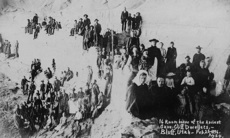History: The White Mesa Utes
|
Three bands comprise the Southern Utes, and the people of White Mesa descend from the Weenuche band. Each band was made up of one to ten families that joined together for hunting and gathering and was led by a political leader, selected to make decisions regarding food and security, and a spiritual leader, who understood how to appeal to the supernatural powers associated with the land. The bands moved with the seasons, migrating based on the harvest of plants and hunting of animals. The Weenuche band lived in an area bounded by the Dolores, Colorado, and San Juan rivers, but like all Southern Utes, they were highly mobile and traveled throughout the Great Basin, Colorado Plateau and into the Great Plains. Primarily due to the introduction of the horse in the late 1600s, the people of White Mesa were able to travel longer distances to acquire food and trade goods. Central to the Weenuche economy were deer, which provided food and clothing and could also be traded with other tribes. The arrival of Europeans ushered in major disruptions in the Ute way of life. Spanish slave raiders, explorers, and traders traveled into Ute territory following the colonization of New Mexico in the late 1500s. Contact with the Spanish introduced the slave trade to the Great Basin. Many Indians were sold or exchanged as slaves, and violence between the Utes, Paiutes, and Navajos became frequent. The slave trade increased after 1829 with the establishment of the Old Spanish Trail, a trade route that connected New Mexico to the Pacific Ocean and traversed Ute lands. When the United States acquired the Southwest from Mexico in 1848, Americans, like the Spanish before them, attempted to exploit tribal rivalries between the Utes and the Navajos to gain control of the region. White settlement began to put serious pressure on Ute lands, and in 1868 the Utes begrudgingly signed a treaty in Washington D.C. that consigned them to western Colorado Territory. Although the reservation did not include the area of the lower San Juan River, in what is now southeastern Utah, the Weenuche continued to use the public lands in this region. For a time, they enjoyed relative isolation, as the white settlers generally ignored this part of the Four Corners region. In the 1880s, however, Mormon settlers moved into the area, followed by cattle companies in search of free grazing lands. Conflict between whites and local Indians frequently ensued. The Utes also found themselves in conflict with the Navajos, whose population in the area expanded in the 1890s. The Southern Utes in living southeastern Utah repeatedly resisted attempts by the federal government to remove them to Ute Mountain Ute Agency at Towaoc, Colorado. Tensions between the Utes and white settlers culminated in the 1923 “Posey War” in San Juan County, Utah. In reality the “war” was a few shots meant to delay a white posse chasing local Utes and Paiutes, who were fleeing for a traditional sanctuary. However, the Posey incident became an excuse for the federal government to send many of the Ute children to the boarding school at the Ute Mountain Ute Agency and force the remaining Utes onto small land allotments near Allen Canyon and Montezuma Creek. Allotment made the Ute lifestyle of hunting and trading over long distances impossible. They were expected to farm, but this proved disastrous due to cultural resistance and competition from better-equipped and more-experienced white neighbors. Accordingly, the Utes turned raising sheep, cattle and horses, which also proved challenging because of limited grazing lands. In 1938, the Utes filed a lawsuit against the U.S. government claiming of forty million dollars in losses from the dispossession of their land. In the 1950s the Utes from all areas won a series of legal battles and settled for $32 million in reparations. The Utes in Allen Canyon set aside part of their share in the settlement for improvements in infrastructure, housing, and services. Starting in the 1950s, the Utes began to build houses on Ute-owned land eleven miles south of Blanding, Utah. Electricity and plumbing were added in the 1960s and 1970s. Now known as White Mesa, the new settlement fostered a sense of community among local the Utes. Today White Mesa residents’ biggest challenge is that they are isolated from their tribal headquarters at Tawaoc. In spite of this challenge, they have developed a Headstart program, daycare center, adult education classes, weekly health clinics, a senior-citizen program, a full-fledged recreation program, and police protection. The tribe provides employment through these programs; they also run a cattle company and convenience store. |


 According to tradition, the people of White Mesa came to the Four Corners region following the creation of the world, when the god Tav-woats released them from a large sack. Anthropologists tell the story differently, suggesting that the closely related Southern Utes and Southern Paiutes entered the Four Corners region between 850 and 430 years ago. The Southern Utes probably split from the Southern Paiutes and about four hundred years ago. Although their languages remained very similar, the Utes developed new technologies, religious traditions, and social structures that distinguished them from their Paiute cousins.
According to tradition, the people of White Mesa came to the Four Corners region following the creation of the world, when the god Tav-woats released them from a large sack. Anthropologists tell the story differently, suggesting that the closely related Southern Utes and Southern Paiutes entered the Four Corners region between 850 and 430 years ago. The Southern Utes probably split from the Southern Paiutes and about four hundred years ago. Although their languages remained very similar, the Utes developed new technologies, religious traditions, and social structures that distinguished them from their Paiute cousins. 

